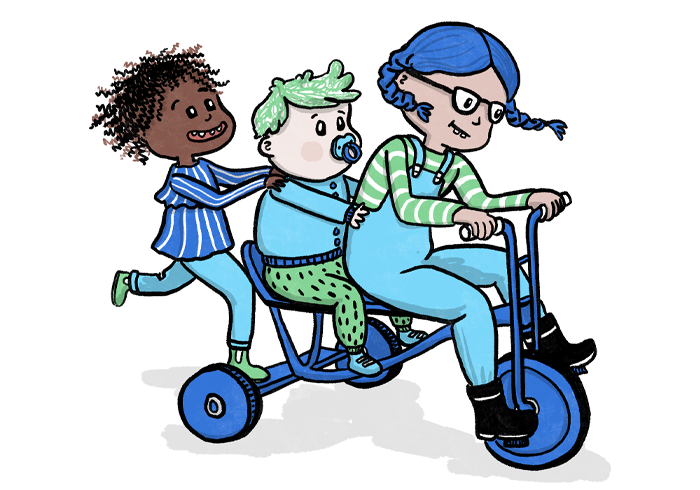Status and well-being of LGBT+ children and adolescents in schools

Numerous studies and surveys have been conducted on the situation of LGBT+ children and adolescents in schools. It's clear that we need to improve to ensure their well-being and learning progress.
Survey on the well-being of LGBT+ youth
In 2017, GLSEN, Samtökin '78 — The National Queer Organization of Iceland, and the University of Iceland's School of Education conducted a survey about the well-being of LGBT+ youth in Icelandic school environments. The survey included LGBT+ students aged 13-20 years, and inquired about feelings of safety in school, prejudiced language use, harassment and violence, the impact of the environment on attendance and academic success, the support of staff, school policies, and curriculum.
The results did not include the responses of students who identify as transgender due to the small size of that group. The main results showed that a third of students reported feeling unsafe at school last year due to their sexual orientation, and a fifth due to their gender expression. Nearly a third of LGBT+ students were verbally harassed due to their sexual orientation, and about a quarter due to their gender expression. In addition, 12.6% LGBT+ students had been physically harassed due to their sexual orientation, 6.2% due to their gender, and 5.3% related to gender expression. The results also showed that staff who were supportive of LGBT+ people had a significant influence on the experiences of LGBT+ students in school, such as the number of staff supporting LGBT+ people (the more, the better), staff stopping prejudiced language against LGBT+ people and those who discussed LGBT+ issues in a positive light in teaching.
LGBT+ students experiencing the above were more likely to say that their fellow students were supportive, they felt they belonged to the school community to a greater extent, and were less likely to be absent from school because they felt unsafe. It's clear that attitudes, knowledge, policy and teaching methods of teachers and other school staff make a big difference when it comes to the well-being of LGBT+ youth in the school environment.
Role of schools
The manual Violence Against Children. Role of Schools emphasizes that LGBT+ students need special care. It points out that silence is one of the most common forms of prejudice against them, and when the silence is broken, the conversation is relegated to homosexuality, with very little discussion about other groups in the LGBT+ community.
Are heterosexual norms predominant in sex education?
The study of Sólveig Rós Másdóttir, The Penis Will Find You (2015) examined whether heterosexual norms were dominant in sex education in the upper primary schools of Reykjavík City. She came to similar results and found that despite some teachers discussing LGBT+ people, the discourse tended to focus on homosexuality and generally reflected heteronormative thinking.
But what about elsewhere?
The US study, The 2017 National School Climate Survey The Experiences of Lesbian, Gay, Bisexual, Transgender, and Queer Youth in Our Nation’s Schools, reached more than 23,000 LGBT+ students aged 13-21. The results showed that 59.5% of LGBT+ students said they were not safe at school due to their sexual orientation, 44.6% due to gender expression, and 35% because of their sex. Almost all (98.5%) LGBT+ students had heard words related to LGBT+ people used in a negative and/or derogatory way, most often due to sexual orientation (95.3%), gender expression (94%), and in relation to transgender people (87.4%). Teachers and other school staff were no exception, with more than half of LGBT+ students hearing teachers or other school staff being homophobic and 71% hearing them speak negatively about gender expression. In addition, over half of those who had experienced some kind of harassment or assault at school didn't report it to school authorities because they had no faith that the matter would be resolved, while 60.4% of those students who reported such incidents said nothing had been done or they were told to ignore the behavior. Approximately 70% of students had experienced verbal harassment or comments related to sexual orientation, 59% due to gender expression, and 53% because of sex. Those LGBT+ students who felt a lot of bullying and discrimination because of their sexuality were less likely to attend school than LGBT+ students who felt less bullying and discrimination. They also had lower exam grades, were embarrassed more often, had lower self-esteem, and were more depressed.
How does an LGBT+ child know that you are supportive?
Given that our society generally assumes a straight cis identity until proven otherwise, it's not surprising that LGBT+ students may feel marginalized or different. They need to regularly come out and often have to defend their own position – if the want to. Such situations can be difficult, particularly if an individual is unsure of the reactions they might face. Therefore, it's important to ask yourself: "How do LGBT+ students know that they are welcome and that they are in a supportive environment?” LGBT+ students, like everyone, wouldn’t know in advance and it is therefore up to the teacher and other staff to ensure that their positive attitude is visible, known, and that a student can be assured of being their authentic self.